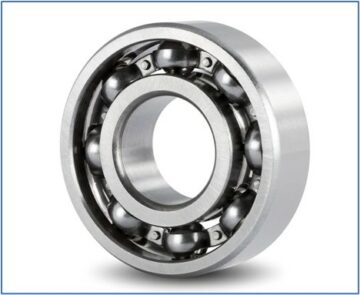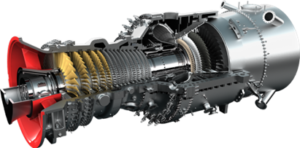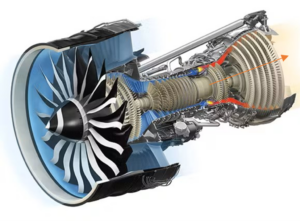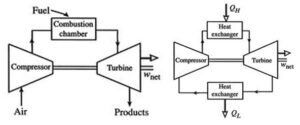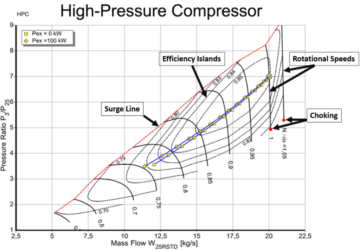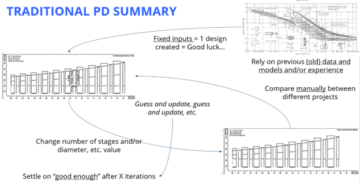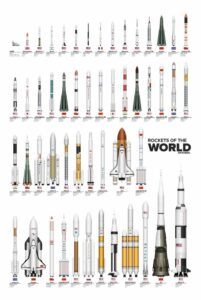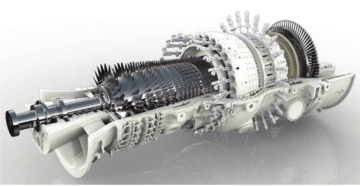Introduction
Aviation is coming into a new age of carbon free energy, similar to what is being explored with ground transportation. Currently, aviation transportation generates about 2.5% of the global CO2 emission [1]. Several countries have introduced targets to achieve net-zero emissions by 2050 [2].
Many aerospace teams have joined the great engineering challenge to change the future of aviation. With this, a number of different types of aircraft with different types of propulsion systems have been proposed.
Hybrid Propulsion System
The first step to a carbon-free propulsion system is hybrid technology. This kind of power plant increases efficiency, decreases emission of greenhouse gases and uses a traditional engine to produce electricity and electric motors to drive the fans or propellers [3].
The chemical engines operate at optimal conditions at any mode of a route. On the other hand, the electric motor is able to work in generator mode, using the kinetic energy of the vehicle during deceleration.

The hybrid aircraft is classified by several attributes. Using thrust devices, we will consider the two base types of propellers and fans.
Propeller Driven Hybrid Aircraft
The first hybrid aircraft to achieve flight was propeller driven. Let’s take a look at the Ampaire Electric EEL as an example. It was modified from a six-seat twin-engine aircraft by adding an electric motor [4]. The cruise altitude is about 15,000 feet at a velocity of 160 knots. The engine power of the engine is about 160 kW.
To design a propeller based aircraft, the basic parameters of Ampaire Electric EEL was used. The turbo-shaft engine was designed for atmosphere data of cruise altitude and velocity to produce the required horizontal flight power. At this mode, all power from the generator was consumed by the electric motor without any additional devices.

The majority of modern propeller-based aircraft may be transformed to hybrid using this simple method. But existing flight vehicles are not the only vehicles which can have a hybrid power plant. For example, the new production aircrafts may use this type to propel. One more advantage of a hybrid propellant system is that you are able to apply a multi-propeller scheme with one combustion engine which has several benefits over a single propeller vehicle such as stability, reliability and safety with using distribution of the force power along the wing span[5].

Fan Driven Hybrid Aircraft
Another application of hybrid propulsion systems is fan driven aircrafts such as the hybrid electric fan from Zunum Aero (backed by Boeing) [6] and the AIRBUS designed Airbus E-Fan X [7]. Let’s explore the Airbus E-Fan X.
This aircraft has a 2 MW gas turbine power pack and one of the turbofan engines has been changed to a fan with an electric motor. The cycle includes two sub-cycles; an electric driven fan assembly and a gas turbine engine.
The gas turbine engine is used at cruise conditions. During climb, both energy sources (gas turbine and electric battery) are used to create thrust. During descent, the gas turbine and partial fan assembly are used to charge the battery. As a result, the gas turbine engine operates at maximum efficiency for the current atmospheric conditions.

Conclusion
The hybrid propulsion system is halfway to the goal of zero emissions and can be approached in a number of different ways. For example, a traditional engine can be used as the electric production source. Alternatively, there are UAVs flying now which are being powered by solar energy or Lithium-ion batteries. Additionally, some of the most promising carbon-free aviation propulsion technology uses fuel elements powered by liquid hydrogen. All of these variants of a combustion engine with a generator need to be explored to change the industry towards a greener source of energy.
Interested in using the AxSTREAM platform for your next electric propulsion project? Check out some of our products below or request a trial through this link
- AxCYCLE – thermodynamic cycle simulation.
- AxSTREAM – turbomachinery component design (fans, compressors, turbines, pumps).
- AxSTREAM RotorDynamics – rotor bearing system design and analysis.
References
- Hannah Ritchie, Climate change and flying: what share of global CO2 emissions come from aviation? / October 22, 2020/ ourworldindata.org
- Achieving net-zero emissions by 2050, iea.org/reports/world-energy-outlook-2020/achieving-net-zero-emissions-by-2050/
- Aigner, M. Nollmann, E. Stumpf, Design of a hybrid electric propulsion system within a preliminary aircraft design software environment / Deutscher Luft- und Raumfahrtkongress 2018
- Francesca Street, Tests to begin on Ampaire electric hybrid passenger airplane / cnn.com
- Ten-Engine Electric Plane Prototype Takes Off, Aug. 7, 2017 / https://www.nasa.gov
- Jeremy Bogaisky, Boeing Backs Away From Zunum Aero, Founders Struggle To Raise Money After Laying Off Staff, Jul 2, 2019 / forbes.com
- E-Fan X, A giant leap towards zero-emission flight / airbus.com
Source: https://blog.softinway.com/modern-challenges-in-aviation-propulsion-system/
- Additional
- ADvantage
- Aerospace
- aircraft
- Airplane
- analysis
- Application
- aviation
- batteries
- battery
- Boeing
- carbon
- challenge
- change
- charge
- chemical
- CNN
- co2
- co2 emissions
- coming
- component
- countries
- cruise
- Current
- data
- Design
- Devices
- driven
- efficiency
- Electric
- electric motor
- electricity
- emission
- Emissions
- energy
- Engineering
- Environment
- Feet
- Figure
- First
- flight
- Forbes
- founders
- Free
- Fuel
- future
- GAS
- Global
- great
- HTTPS
- Hybrid
- hydrogen
- IEA
- industry
- IT
- lightning
- Liquid
- Majority
- money
- Nasa
- Other
- power
- Production
- Products
- project
- pumps
- raise
- Route
- Safety
- Share
- Simple
- simulation
- Software
- solar
- Stability
- street
- system
- Systems
- Technology
- tests
- The Future
- transportation
- trial
- turbine
- vehicle
- Vehicles
- VeloCity
- What is
- Wing
- within
- Work
- X
- zero

